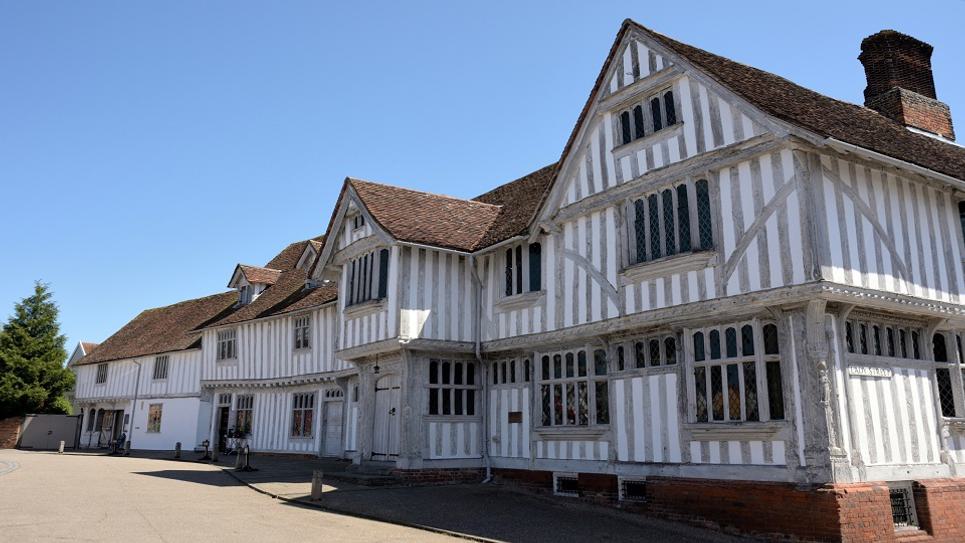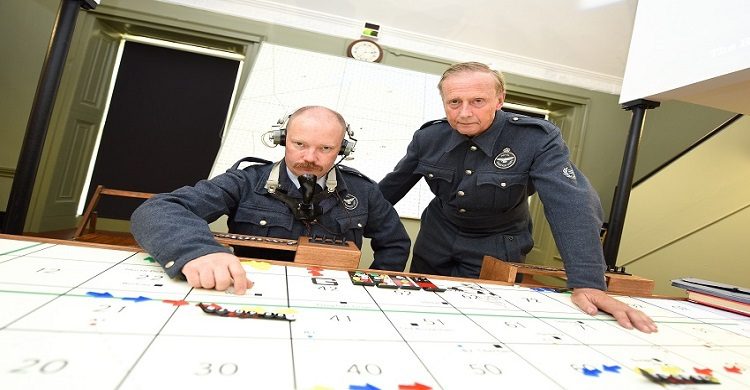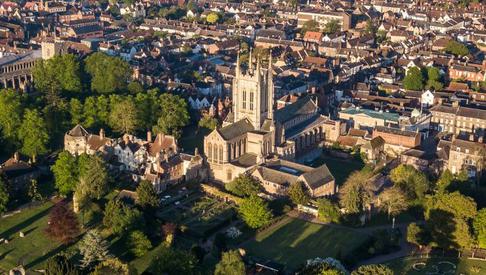
Back to Blogs
Discover
Bury St Edmunds' Horrible Histories!
Discover the gruesome tales in Bury St Edmunds' murky past...
On the surface Bury St Edmunds boasts delightful gardens, historic buildings and a lively atmosphere, but dig beneath the surface of this pleasant market town and you’ll find a much darker past. Delve into the tales that give Bury St Edmunds and the surrounding area a gruesome reputation for countless stories of murder, death and execution.
Plague in Bury St Edmunds

The Bury St Edmunds Plague Stone. Photo: Jo Sweetman
In the year 1349 Suffolk residents found themselves the latest victims of the bubonic plague, or the black death. Brought to Britain by fleas upon rats, aboard boats coming from France, it spread incredibly quickly and due to a long incubation time was passed between unwitting folk at a high rate.
Like all towns, Bury St Edmunds’ population was decimated by the black death; passing between people in the tightly packed streets and causing headaches, chills and vomiting, as well as painful sores or buboes underneath the arms, half of the people to get ill perished.
Desperate folk tried to concoct ‘cures’, burning herbs, sitting in sewers and even taking arsenic. A recipe for a fermented vinegar and herb mixture was widely circulated and many erroneously believed it could protect against the pestilence.
Plague stones were erected in towns and cities, hollowed out and filled with the vinegar mixture for passers by.
One such stone still remains at Risbygate Street in Bury St Edmunds and bears the inscription: "It is believed that this stone was the base of a settlement cross which stood on this site for many centuries and which was probably destroyed during the civil war. Legend has it that in the time of pestilence the hollow in the stone was filled with vinegar so that travellers could disinfect their money."
The Red Barn Murder

Red Barn Murder exhibit at Moyse's Hall Museum. Photo: Phil Morley
Perhaps the most infamous of gruesome tales originating in the Bury St Edmunds area, the Red Barn Murder and the trial and execution of William Corder, is full of intrigue. The story goes that Corder- a man of dubious morals, found himself under pressure to marry Maria Marten, with whom he had fathered a child. Not wanting to be tied down, William tricked Maria, suggesting they elope after meeting at local landmark, the red barn in Polstead.
Though no-one can be sure of what exactly occurred in the barn on that fateful day in 1824, it soon became apparent that William Corder had not in fact eloped with Maria but had instead run away, appearing in London and the Isle of Wight, advertising for a wife in The Times newspaper, and eventually setting up a finishing school for girls, all the while giving excuses as to Maria’s whereabouts.
Unbeknownst to William, back in Polstead, Maria’s stepmother had begun to report of having unusual and highly specific dreams indicating that Maria could be found in the Red Barn. Sure enough, after a short search, her body was uncovered, with evidence of having been shot, stabbed and possibly strangled- her throat tied with William’s green neckerchief.
The mission to apprehend William Corder began immediately and he was brought back to Suffolk and confined at Bury St Edmunds, before being found guilty and sentenced to hang and his body be dissected and atomized. The public was fascinated by the whole affair, with 20,000 people flocking from far and wide to witness the hanging on 11th August 1828. The story of this most dastardly murder caught the imagination of all who heard about it and became the inspiration for many melodramas, ballads and stories.
Visitors to Moyses Hall Museum in Bury St Edmunds can see the Corder’s macabre plaster death bust, a piece of his scalp and, most eerie of all, a book recounting the murder, bound in leather made of Corder’s skin.

The book bound in the skin of Red Barn Murderer William Corder and Pistols used in the Murder on display at Moyse's Hall Museum. Photo: Keith Mindham.
Witchcraft and Superstitition

Witchcraft Exhibit at Moyse's Hall Museum featuring wands and mummified cats. Photo: Phil Morley.
Religious, political and economic uncertainty during the 16th and 17th Centuries generated heightened fear of witches and witchcraft.
To keep witches at bay people used charms and curses in their homes .
At Moyse's Hall Museum you can see witch bottles said to contain curses and counter-curses which would be hidden in places of significance.
Cats were buried in walls and under floorboards to act as spiritual guardians of properties, and you can see some at the museum that were found in villages near Bury St Edmunds. The most famous Suffolk mummified cats are at The Nutshell Pub in Bury St Edmunds where one hangs above the bar. It is around 400 years old and was discovered behind the fireplace in 1935 during building work. Intended to ward off evil spirits, local legend says that touching it brings bad luck.
In Sudbury's Mill Hotel, local legend states that the ritually deposited cat was once removed and a huge fire broke out at the mill. The cat was swiftly returned and lays behind the window in the reception area of the hotel to this day.
Shoes were also concealed in walls, fireplaces and lofts believed to take the form and smell of the wearer.

Shoes were also concealed in walls, fireplaces and lofts to ward off evil spirits. Photo: Phil Morley
Suffolk Witch Trials

Crime Timeline at Moyse's Hall Museum. Photo: Phil Morley
For several decades, Suffolk was at the heart of numerous trials that saw the murder of multiple innocent women and men who were accused of witchcraft. The infamous witchfinder general Matthew Hopkins travelled to East Anglia in the summer of 1645, finding and bringing to trial 117 witches and wizards, though only 17 of those arrested were male.
The largest single witch trial in England took place in Bury St Edmunds and 18 people were hanged. Hopkins benefited greatly from the trials as he was paid by local parishes to seek out the accused. The public’s hysteria around the subject lead to fingers being pointed in the direction of anyone on the outskirts of society- usually single, elderly men and women.
One particularly well known case concerned two elderly widows- Rose Cullender and Amy Denny, who were brought to trial in 1662 at the Assizes Bury St Edmunds and found guilty of 13 charges of using malevolent witchcraft. The evidence was comprised of a range of bizarre accusations including the deaths of local pigs and cattle, causing a child to vomit pins and nails and causing a toad to fall from a child’s blanket.
They were sentenced to death and hanged at Thingoe Hill in Bury St Edmunds a week later. The trial set a devastating precedent for future trials, even influencing those that took place in the American colonies, allowing magistrates to use dreams and visions as proof in a court of law.
In 1735 the Witchcraft Act abolished the execution of witches in England.
Find out about the Bury St Edmunds Witch Trials at Moyse's Hall Museum.
The History of Lavenham Guildhall

The nearby village of Lavenham is home to the historic Guildhall, which itself houses the curious tale of young Ann Baker. Though it now boasts a museum and even a tea room, the 500 year old building has played many roles throughout the years, including a religious meeting place for merchants, a school, an inn, a workhouse and most chillingly, the ‘Bridewell’ or house of correction.
In October 1785 it became the new home of a runaway orphan, the 12-year old Ann Baker. Ann came to the Bridewell after her second attempt at escaping from the workhouse. She was tried at Bury St Edmunds court and judged an ‘incorrigible rogue’ before being sentenced to ‘seven years transportation’.
The time Ann spent at the Bridewell awaiting her fate was a punishment in itself; locked up all day, with nothing but the freezing stone floor to sit on and all at such a young age. In 1789 she began a grueling journey to the British penal colony in Australia along with thousands of others aboard the convict ship ‘Neptune’. The conditions on the ship were ghastly, and witnesses recorded that upon arrival those who had not perished en route were in a sorry state, crawling with lice, filthy and so weak that they were unable to stand.
Despite this, Ann somehow managed to survive the 159 day journey and completed her sentence, even going on to marry and have a family before her death aged only 29.
The Acton Dumpling Murderess
This fascinating tale centers around young Catherine Foster; the last woman to be publicly hanged in Bury St Edmunds (in 1847), and the subject of great speculation in regards to her guilt and motive.
Aged just 17, Catherine was seemingly happily married to her husband John Foster for only 3 weeks before he was taken suddenly ill with fever and vomiting, and soon after he died. Catherine told of how she had fed John his usual meal of suet dumplings and was alarmed to see him taken ill.
Suspicions were aroused when it was reported that after the remains of the dumplings had been thrown away in the garden, the hens that had eaten it had also perished. When the house was investigated police found evidence of arsenic on the muslin cloth used to cook the suet dumpling and Catherine was brought to trial for murder.
She was reported as being unusually calm in court, and staunchly denied any guilt. However, the public were fascinated by the trial and speculated that Catherine loved another and hoped to do away with her husband and elope, though no such person was ever discovered. When she heard the verdict, Catherine was composed, a demeanor she retained until her execution; when asked for her last words she simply said “no, I cannot speak”. In a letter to her mother Catherine confided that she was unafraid of death as she would go to a better place and be reunited with John, leading many to question how John really met his end, perplexing indeed.
Related Posts
Related Blogs

News
Bury Tour Guides to launch…
Bury St Edmunds Tour Guides to Introduce new tours in…

News
Town’s Museum Forms New…
Moyse’s Hall Museum will be forging links with a…

News
St Edmundsbury Cathedral…
St Edmundsbury Cathedral in Bury St Edmunds is…

News
Bury St Edmunds & Beyond…
Step inside many of Bury St Edmunds historic buildings…

News
Bury's Best Pubs with a Past
some notable, historic and somewhat quirky pubs and…
Latest news

News
How to Spend Betwixtmas in Bury St Edmunds & Beyond
The post Christmas period is the perfect time to get out and about before the new year kicks in, and you’ll find plenty of activities and places to visit in Bury St Edmunds and beyond.

News
Parents Guide to Pre Christmas Entertainment
It's the school holidays and with Christmas just around the corner we've put toegther a guide on places to take the kids to keep them entertained until Santa visits!

News
Enjoy a Festive Afternoon Tea in 2025
Celebrate the Christmas season with a festive afternoon tea in Bury St Edmunds & Beyond...

News
Festive Winter Walks
Get outside and enjoy the fresh crisp winter air with one of these walks in Bury St Edmunds and Beyond!

News
Bury Tour Guides to launch new tours next year after successful 2025
Bury St Edmunds Tour Guides to Introduce new tours in 2026 and continue the successful Food and Drink Tours!

News
New in Bury St Edmunds For 2026
A sneak peak into new attractions visitors can enjoy in Bury St Edmunds in 2026.

News
Baby It's Cold Outside... Things To Do When the Weather Turns Frosty
Just because the temperature’s dropped doesn’t mean the fun has to! If you’re visiting town during the chillier months, there’s still plenty to see, do, and experience.

News
Places to sit by a roaring fire in Bury St Edmunds & Beyond
Warm up by a roaring fire this winter in Bury St Edmunds & Beyond...

News
Festive Theatre Guide 2025
There’s no better way to summon the magic of the festive season than a trip to the theatre.


